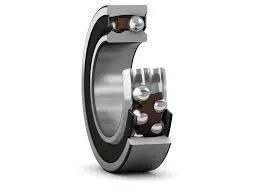
10 月 . 09, 2024 06:04 Back to list
angular contact ball bearing
Understanding Angular Contact Ball Bearings
Angular contact ball bearings are a specialized type of rolling-element bearing designed to accommodate both radial and axial loads. Characterized by their unique geometry, they play a pivotal role in various engineering applications, particularly in high-speed and high-load situations. This article delves into the features, advantages, and applications of angular contact ball bearings.
Structure and Design
The defining feature of angular contact ball bearings is the angle at which the raceways are designed. Unlike conventional deep groove ball bearings, the inner and outer raceways of angular contact bearings are inclined relative to the axis of rotation. This design enables the bearing to handle axial loads in one direction effectively, making them ideal for applications where combined loads exist. The more acute the contact angle, the higher the axial load capacity. Common contact angles range from 15° to 40°, with the choice of angle influencing the bearing's load handling capability and overall performance.
Angular contact ball bearings are available in various configurations, including single-row, double-row, and even four-point contact designs. The single-row variants are widely used for their simplicity and versatility, while double-row bearings provide enhanced load capacity and are typically used in applications with higher radial forces. Some designs also feature separable components, allowing for easier maintenance and assembly.
Advantages of Angular Contact Ball Bearings
1. High Load Capacity Angular contact ball bearings can handle a combination of radial and axial loads, making them suitable for dynamic conditions. Their design facilitates the support of heavier loads without sacrificing performance.
2. Reduced Friction The rolling motion of the balls in the raceways minimizes frictional resistance. This feature is crucial for high-speed applications where reduced heat generation is essential.
3. Enhanced Stability Due to their ability to handle axial loads, these bearings provide increased stability and performance in applications susceptible to fluctuations in load direction.
4. Versatility Angular contact ball bearings can be adapted to suit a wide variety of application requirements, ranging from high-speed machinery to precision instruments.
angular contact ball bearing

Applications
Angular contact ball bearings are utilized in numerous industries and applications due to their unique properties
- Machine Tools In the precision machinery sector, these bearings are integral to spindle assemblies, where they support the combined rotational and axial loads essential for precision cutting.
- Aerospace The aerospace industry relies on angular contact ball bearings in landing gear and engine applications, where they endure extreme loads while maintaining operational efficiency.
- Automotive In automotive applications, these bearings are used in gearboxes, electric motors, and wheel hubs, where they help manage the dynamic loads exerted during movement.
- Electric Motors Angular contact bearings can handle the axial loads generated during the operation of electric motors, contributing to their reliability and efficiency.
- Robotics The high precision and load-handling capabilities make angular contact ball bearings suitable for robotic joints and actuators, enhancing their performance in automation and manufacturing environments.
Conclusion
Angular contact ball bearings are an essential component in various mechanical systems, providing unique benefits that are critical for performance in demanding situations. Their ability to handle both radial and axial loads, coupled with their durability and versatility, makes them a popular choice among engineers and manufacturers. As technology advances and the demand for high-performance components grows, the importance of angular contact ball bearings in industrial applications is likely to continue rising, underscoring their vital role in modern engineering.
Latest news
-
Unlocking Efficiency with Spherical Roller Bearings
NewsOct.29,2024
-
The Ultimate Guide to Thrust Ball Bearings
NewsOct.29,2024
-
The Power of Thrust Roller Bearings: Engineered for Excellence
NewsOct.29,2024
-
The Power of Deep Groove Ball Bearings for Your Application Needs!
NewsOct.29,2024
-
The Power and Performance of Cylindrical Roller Bearings
NewsOct.29,2024
-
High-Quality Ball Bearing Manufacturing Machines
NewsOct.29,2024
